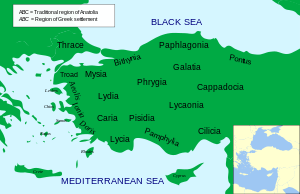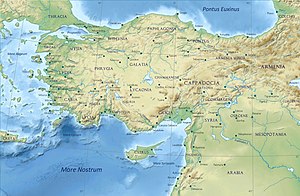Paphlagonia
| Paphlagonia (Παφλαγονία) | |
|---|---|
| Ancient Region ofAnatolia | |
| Location | North centralAnatolia,Turkey |
| State existed | 5th century - 183 BC |
| Historical capitals | Gangra (modern-dayÇankırı,Turkey) |
| Achaemenidsatrapy | Cappadocia |
| Roman province | Pontus |
 | |
 | |
Paphlagonia(/ˌpæfləˈɡoʊniə/;Greek:Παφλαγονία,romanized:Paphlagonía,modern translit.Paflagonía;Turkish:Paflagonya) was an ancientregionon theBlack Seacoast of north-centralAnatolia,situated betweenBithyniato the west andPontusto the east, and separated fromPhrygia(later,Galatia) by a prolongation to the east of theBithynian Olympus.According toStrabo,the region was bounded by the riverPartheniusto the west and theHalys Riverto the east. Paphlagoniawas said to be named after Paphlagon, a son of the mythicalPhineus.[1]
Location[edit]
The greater part of Paphlagonia is a rugged mountainous country, but it contains fertile valleys and produces a great abundance of hazelnuts and fruit – particularly plums, cherries and pears. The mountains are clothed with dense forests, notable for the quantity of boxwood that they furnish. Hence, its coasts were occupied byGreeksfrom an early period. Among these, the flourishing city ofSinope,founded by colonists fromMiletusin ca. 630 BC, stood pre-eminent.Amastris,a few miles east of the Parthenius river, became important under the rule of the Macedonian monarchs; whileAmisus,a colony of Sinope situated a short distance east of the Halys river (and therefore not strictly in Paphlagonia as defined by Strabo), grew to become almost a rival of its parent city.
The most considerable towns of the interior wereGangra– in ancient times the capital of the Paphlagonian kings, afterwards calledGermanicopolis,situated near the frontier ofGalatia– andPompeiopolis,in the valley of theAmniasriver, near extensive mines of the mineral called by Strabosandarake(red arsenic or arsenic sulfide), largely exported fromSinope.
History[edit]
In the time of theHittites,Paphlagonia was inhabited by theKashkapeople, whose exact ethnic relation to the Paphlagonians is uncertain. It seems perhaps that they were related to the people of the adjoining country,Cappadocia,[clarification needed]who were speakers of one of theAnatolianbranch of theIndo-European languages.Their language would appear, from Strabo's testimony, to have been distinctive.

The Paphlagonians were one of the most ancient nations ofAnatoliaand were listed among the allies of the Trojans in theTrojan War(ca. 1200 BC or 1250 BC), where their kingPylaemenesand his son Harpalion perished (Iliad,ii. 851–857). According toHomerandLivy,a group of Paphlagonians, called theEnetoiin Greek, were expelled from their homeland during a revolution. With a group of defeated Trojans under the leadership of the Trojan prince Antenor, they emigrated to the northern end of theAdriaticcoast and later merged with indigenousEuganei,giving the nameVenetiato the area they settled.

Paphlagonians were mentioned byHerodotusamong the peoples conquered byCroesus,and they sent an important contingent to the army ofXerxesin 480 BC.Xenophonspeaks of them as being governed by a prince of their own, without any reference to the neighboringsatraps,a freedom perhaps due to the nature of their country, with its lofty mountain ranges and difficult passes. All these rulers appear to have borne the namePylaimenesas a sign that they claimed descent from the chieftain of that name who figures in theIliadas leader of the Paphlagonians.
Under the Kingdom of Pontus[edit]
At a later period, Paphlagonia passed under the control of the Macedonian kings, and after the death ofAlexander the Great,it was assigned, together withCappadociaandMysia,toEumenes.However, it continued to be governed by native princes until it was absorbed by the encroaching power ofPontus.The rulers of that dynasty became masters of the greater part of Paphlagonia as early as the reign ofMithridates Ctistes(302–266 BC), but it was not until 183 BC thatPharnacesreduced theGreekcity ofSinopeunder their control. From that time, the whole province was incorporated into thekingdom of Pontusuntil the fall ofMithridates(65 BC).
Roman and Byzantine empires[edit]
Pompeyunited the coastal districts of Paphlagonia, along with the greater part of Pontus, with the Roman province ofBithynia et Pontus,but left the interior of the country under the native princes, until the dynasty became extinct and the whole country was incorporated into theRoman Empire.The name was still retained by geographers, though its boundaries are not distinctly defined by the geographer ClaudiusPtolemy.Paphlagonia reappeared as a separate province in the 5th century AD (Hierocles,Synecdemusc. 33). In the 7th century it became part of thethemeofOpsikion,and later of theBucellarian Theme,before being split off c. 820 to form aseparate provinceonce again. Under the Byzantine Empire, Greeks often disparaged Paphlagonians as crooks, particularly in the 10th to 12th centuries. During this period, the high profile of Paphlagonians in positions of power, such as court eunuchs, often attracted backlash from the rest of society.[2]
Notable people[edit]
- Artoxares(5th century BC) eunuch, envoy ofPersian kingsArtaxerxes IandDarius II
- Diogenes of Sinope(4th century BC) Greek philosopher, one of the founders ofCynicphilosophy.
- Alexander of Abonoteichus(c. 105 – c. 170 AD), also called Alexander the Paphlagonian, or the false prophet Alexander
- Saint Philaretos(8th century)
- Theodora(9th century), wife of the Byzantine emperor Theophilus
- John Mauropous(11th century), Eastern Roman poet and author
- Michael IV the Paphlagonian(c. 1010 - 1041 AD), Byzantine emperor
- Eumenes of Cardia(until he decided to leave for Troja and return to Cardia)
See also[edit]
References[edit]
- ^Eustath. ad Horn. II. ii. 851, ad Dion. Per. 787; Steph. B. t.v.; Const. Porph. de Them. i. 7.
- ^Alexandru Avram, Gocha R. Tsetskhladze, James Hargrave (2021).The Greeks and Romans in the Black Sea and the Importance of the Pontic Region for the Graeco-Roman World (7th Century BC-5th Century AD): 20 Years On (1997–2017).Archaeopress Publishing Limited. p. 176.ISBN9781789697599.
{{cite book}}:CS1 maint: multiple names: authors list (link)
- Attribution
- This article incorporates text from a publication now in thepublic domain:Chisholm, Hugh,ed. (1911). "Paphlagonia".Encyclopædia Britannica.Vol. 20 (11th ed.). Cambridge University Press.
External links[edit]
- Paphlagonia
- Historical regions of Anatolia
- History of the Black Sea
- Byzantine Anatolia
- Praetorian prefecture of the East
- Provinces of the Byzantine Empire
- 5th-century BC establishments
- States and territories established in the 5th century BC
- States and territories disestablished in the 2nd century BC
- History of Bartın Province
- History of Kastamonu Province
- History of Sinop Province
- History of Çankırı Province
- History of Karabük Province

